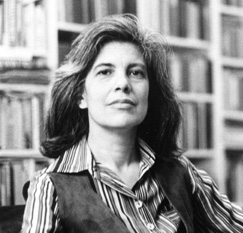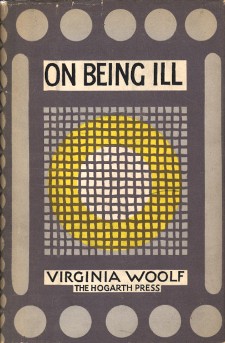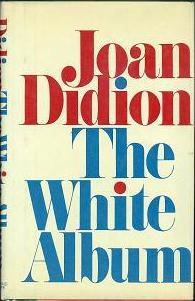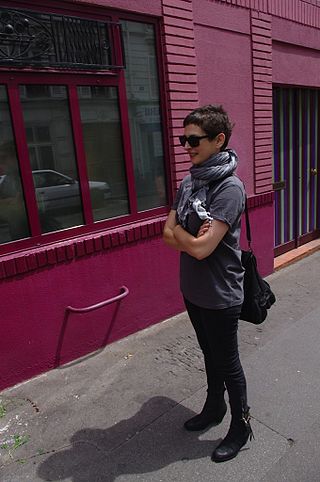Related Research Articles

Maxine Hong Kingston is an American novelist. She is a Professor Emerita at the University of California, Berkeley, where she graduated with a BA in English in 1962. Kingston has written three novels and several works of non-fiction about the experiences of Chinese Americans.

Creative nonfiction is a genre of writing that uses literary styles and techniques to create factually accurate narratives. Creative nonfiction contrasts with other nonfiction, such as academic or technical writing or journalism, which are also rooted in accurate fact though not written to entertain based on prose style. Many writers view creative nonfiction as overlapping with the essay.

Susan Lee Sontag was an American writer, critic, and public intellectual. She mostly wrote essays, but also published novels; she published her first major work, the essay "Notes on 'Camp' ", in 1964. Her best-known works include the critical works Against Interpretation (1966), On Photography (1977), Illness as Metaphor (1978) and Regarding the Pain of Others, as well as the fictional works The Way We Live Now (1986), The Volcano Lover (1992), and In America (1999).

Joan Didion was an American writer and journalist. She is considered one of the pioneers of New Journalism along with Gay Talese, Hunter S. Thompson, and Tom Wolfe.
Julia B. Cameron is an American teacher, author, artist, poet, playwright, novelist, filmmaker, composer, and journalist. She is best known for her book The Artist's Way (1992). She also has written many other non-fiction works, short stories, and essays, as well as novels, plays, musicals, and screenplays.
Uta Barth is a contemporary German-American photographer whose work addresses themes such as perception, optical illusion and non-place. Her early work emerged in the late 1980s and 1990s, "inverting the notion of background and foreground" in photography and bringing awareness to a viewer's attention to visual information with in the photographic frame. Her work is as much about vision and perception as it is about the failure to see, the faith humans place in the mechanics of perception, and the precarious nature of perceptual habits. Barth's says this about her art practice: “The question for me always is how can I make you aware of your own looking, instead of losing your attention to thoughts about what it is that you are looking at." She has been honored with two National Endowments of the Arts fellowships, was a recipient of the John Simon Guggenheim Fellowship in 2004‑05, and was a 2012 MacArthur Fellow. Barth lives and works in Los Angeles, California.

A Room of One's Own is an extended essay by Virginia Woolf, first published in September 1929. The work is based on two lectures Woolf delivered in October 1928 at Newnham College and Girton College, women's colleges at the University of Cambridge.

Sooni Taraporevala is an Indian screenwriter, photographer, and filmmaker who is the screenwriter of Mississippi Masala, The Namesake and Oscar-nominated Salaam Bombay!, all directed by Mira Nair. She also adapted Rohinton Mistry's novel Such A Long Journey and wrote the films Dr. Babasaheb Ambedkar, her directorial debut Little Zizou, and Yeh Ballet, a Netflix original film that she wrote and directed.

Ann Patchett is an American author. She received the 2002 PEN/Faulkner Award and the Orange Prize for Fiction in the same year, for her novel Bel Canto. Patchett's other novels include The Patron Saint of Liars (1992), Taft (1994), The Magician's Assistant (1997), Run (2007), State of Wonder (2011), Commonwealth (2016), The Dutch House (2019), and Tom Lake (2023). The Dutch House was a finalist for the 2020 Pulitzer Prize for Fiction.
Janet R. Maslin is an American journalist, best known as a film and literary critic for The New York Times. She served as a Times film critic from 1977 to 1999 and as a book critic from 2000 to 2015. In 2000, Maslin helped found the Jacob Burns Film Center in Pleasantville, New York. She is president of its board of directors.

On Being Ill is an essay by Virginia Woolf, which seeks to establish illness as a serious subject of literature along the lines of love, jealousy and battle. Woolf writes about the isolation, loneliness, and vulnerability that disease may bring and how it can make even the maturest of adults feel like children again.

The White Album is a 1979 book of essays by Joan Didion. Like her previous book Slouching Towards Bethlehem, The White Album is a collection of works previously published in magazines such as Life and Esquire. The subjects of the essays range widely and represent a mixture of memoir, criticism, and journalism, focusing on the history and politics of California in the late 1960s and early 70s. With the publication of The White Album, Didion had established herself as a prominent writer on Californian culture. As critic Michiko Kakutani stated, "California belongs to Joan Didion."
Shalom Auslander is an American novelist, memoirist, and essayist. He grew up in a strict, Orthodox neighborhood in Monsey, New York, where he describes himself as having been "raised like a veal", a reference to his strict religious upbringing. His writing style is notable for its existentialist themes, biting satire and black humor. His non-fiction often draws comparisons to David Sedaris, while his fiction has drawn comparisons to Franz Kafka, Samuel Beckett, and Groucho Marx. His books have been translated into over a dozen languages and are published around the world.
Louise A. DeSalvo was an American writer, editor, professor, and lecturer who lived in New Jersey. Much of her work focused on Italian-American culture, though she was also a renowned Virginia Woolf scholar.
Janet Burroway is an American author. Burroway's published oeuvre includes eight novels, memoirs, short stories, poems, translations, plays, two children's books, and two how-to books about the craft of writing. Her novel The Buzzards was nominated for the 1970 Pulitzer Prize. Raw Silk is her most acclaimed novel thus far. While Burroway's literary fame is due to her novels, the book that has won her the widest readership is Writing Fiction: A Guide to Narrative Craft, first published in 1982. Now in its 10th edition, the book is used as a textbook in writing programs throughout the United States.

Kristine McKenna is an American journalist, critic and art curator best known for her interviews with artists, writers, thinkers, filmmakers and musicians. Many of these have been collected in Book of Changes (2001) and Talk to Her (2004). Among the people she has interviewed and written about most often over the years are Exene Cervenka, Leonard Cohen, David Lynch, Captain Beefheart, Brian Eno and Dan Hicks.

Kate Zambreno is an American novelist, essayist, critic, and professor. She teaches writing in the graduate nonfiction program at Columbia University and at Sarah Lawrence College. Zambreno is a 2021 Guggenheim Fellow in Nonfiction.
"Modern Fiction" is an essay by Virginia Woolf. The essay was published in The Times Literary Supplement on April 10, 1919 as "Modern Novels" then revised and published as "Modern Fiction" in The Common Reader (1925). The essay is a criticism of writers and literature from the previous generation. It also acts as a guide for writers of modern fiction to write what they feel, not what society or publishers want them to write.
K. C. Cole is an American science writer, author, radio commentator and professor emerita at the USC Annenberg School for Communication and Journalism. She has covered science for The Los Angeles Times since 1994, as well as writing for many other publications, and has been described as "the queen of the metaphor in science writing".

Jeanne Darst is an American author. She is a regular contributor to This American Life and has written for The New York Times, The New York Times Magazine, and Vogue. Her memoir, Fiction Ruined My Family, was published in October 2011 by Riverhead Books.
References
- ↑ "This Writer on Her Work: Janet Sternburg". Poets & Writers. 20 (3): 39–51. May–June 1992.
- ↑ "White Matter | Janet Sternburg".
- ↑ "CALARTS PRESIDENT STEVEN D. LAVINE TO STEP DOWN IN SPRING OF 2017 | CalArts". Archived from the original on 2017-01-18. Retrieved 2017-03-15.
- ↑ "Trial Spawned Theater". Dallas Morning News. June 7, 1970.
- ↑ Osborne, Linda Barrett (September 14, 1980). "Rooms of Their Own". The Washington Post.
- ↑ Bauermeister, Erica; et al. (1994). 500 Great Books by Women . Penguin Books. ISBN 978-0140175905.
- ↑ "Federation Reports: A Conversation with Janet Sternburg and Barbara Abrash". National Federation of State Humanities Council. 5 (1): 4–6. January–February 1982.
- ↑ Kaufman, David (March 3, 1983). "Reading Writers Turn on the Public". East Side Arts.
- ↑ Sternburg, Janet (1982). Historians and Filmmakers: Toward Collaboration. New York: The Institute for Research in History. ISBN 0913865036.
- ↑ "Media Show Strikes at Culture Bias". Christian Science Monitor. May 1992. Retrieved 15 April 2014.
- ↑ Proffitt, Steve (March 5, 1995). "Steven Lavine: At CalArts, Inventing the Art of the Future Today". Los Angeles Times. Retrieved 15 April 2014.
- ↑ Scott, Whitney (March 15, 2002). "Phantom Limb (review)". Booklist. 98.
- ↑ "Janet Sternburg's White Matter Examines Medical and Family Legacies".
- ↑ "White Matter | Janet Sternburg".
- ↑ "The Big Indie Books of Fall 2015".
- ↑ "Book Review: 'White Matter' a Memoir of Family and Medicine by Janet Sternburg". Forbes .
- ↑ Sang-hee, Han (April 9, 2009). "Discovering Beauty with Disposable Cameras". The Korea Times.
- ↑ Insatiable Desires: New Acquisitions. Los Angeles: The Fisher Museum. 2005.
- ↑ "Aperture 166: Spring 2002". Aperture. Archived from the original on 16 April 2014. Retrieved 15 April 2014.
- ↑ Sternburg, Janet (Spring 2002). "A Writer's Need to See". Art Journal. 61 (1): 48–57. doi:10.2307/778167. JSTOR 778167.
- ↑ Rohwer, Jörn Jacob (November 2005). "The Lyrical View: Janet Sternburg" in "The Behaviour of Light" (exhibition catalog). Berlin: U.S. Embassy.
- ↑ Lecrivain, Marie. "Optic Nerve: Poems with Photographs (review)". Subtle Tea. Retrieved 15 April 2014..
- ↑ "Movers and Shakers: The 40 Most Exciting Soulful Artists of 2003". Utne Reader. Retrieved 15 April 2014.